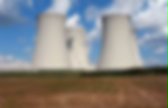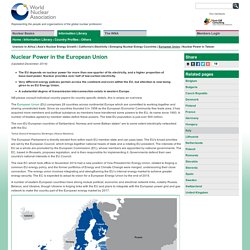

Advance Information 6GE03 Unit 3 Contested Planet Section B – ‘Energy Security’ (January 2013)
Nuclear Energy Futures. IAEA - Global Status of Nuclear Power 2008. Uranium a hot topic again, in Greenland. The upcoming general elections in Greenland may see the country moving away from the idea of extracting and exploiting uranium, which the government voted in favour of just a year ago.

Uranium mining, the hottest topic in the the cold, Arctic country in recent years, was put on the agenda by former prime minister Aleqa Hammond in 2013, after 25 years with a 'zero tolerance' policy to mining of radioactive substances and oil drilling. Uranium is a heavy metal which can be both toxic and radioactive, and affect a person's kidney, brain, liver and heart after exposure. It is used as, among other things, fuel for nuclear power plants. According to Hammond, a Greenlandic mineral and oil venture would add big profits to the country's sluggish economy, which is deeply dependent on fisheries and tourism, and eventually lead to Greenland's independence from Denmark. In October 2013, the Greenlandic government voted in favour of mining radioactive materials after a heated debate by 15-14 votes. The EU's nuclear links with Russia. EU approves Hinkley Point nuclear power station as costs raise by £8bn. The European commission on Wednesday gave Britain the green light for a huge government subsidy that will open the way for the first atomic power stations to be built for nearly 20 years.

The ruling was welcomed by ministers and the nuclear industry but Austria threatened legal action against it, while consumer champions said it could add more than £5bn a year to energy bills. A majority of commissioners agreed Britain was not breaking state aid rules, overcoming the last regulatory hurdle for EDF Energy and its plan to construct Hinkley Point C in Somerset, south-west England.
EDF believes the project will cost £16bn but the EC claimed construction costs alone by the time the plant is built in 2023 will be more than £24bn with a further possible £10bn of contingency payments. Joaquín Almunia, EC competition commissioner, had earlier overseen a heavily critical report on the subsidy arrangements drawn up by the UK Department of Energy and Climate Change (DECC).
Ukraine's recent nuclear reactor scare harkens back to ghosts of historic nuclear accidents. A ferris wheel remains abandoned near the Chernobyl nuclear power plant.

(Getty Images) One of the reactors in Europe’s largest nuclear power plant in southern Ukraine suffered an accident that triggered an automatic shutdown this week. Reports suggest that damage occurred to a transformer in one of the 1000-megawatt reactors at the Zaporizhye plant, which provides over one-fifth of the country’s electricity. Ukraine’s energy minister said that it was a “technical fault” and assured the public that there was “no threat” to the reactor’s safety, according to BBC News. With the country already suffering fuel shortage, Ukraine this winter will probably be forced to import electricity from Russia. Accidents at nuclear rectors makes folks understandably nervous, and is also a reminder that despite all the climate change benefits we get from nuclear energy – like cutting greenhouse gas emissions – there are a lot of risks associated with it, too.
EU should incentivize use of nuclear power, says IEA. The European Union should complement its Emissions Trading Scheme (EU ETS) with policies to attract "critical investment" in low-carbon technologies - including renewable energies, nuclear power and carbon capture and storage (CCS) – "through sector-specific measures to enhance technology innovation and address non-economic barriers," the International Energy Agency (IEA) said in a report issued today.

Nuclear Power in the European Union. (Updated December 2014) The EU depends on nuclear power for more than one-quarter of its electricity, and a higher proportion of base-load power.

Nuclear provides over half of low-carbon electricity.Very different energy policies pertain across the continent and even within the EU, but attention is now being given to an EU Energy Union.A substantial degree of transmission interconnection exists in western Europe. NB please consult individual country papers for country-specific details, this is simply an overview. The European Union (EU) comprises 28 countries across continental Europe which are committed to working together and sharing unrestricted trade.
Since six countries founded it in 1958 as the European Economic Community free trade area, it has acquired more members and political substance as members have transferred some powers to the EU, its name since 1993. The European Parliament is directly elected from within each EU member state and can pass laws. International Nuclear Events Scale (INES) Nuclear power mapped. In Depth. United Nations Global Issues and Nuclear Power. The UN and the nuclear age were born almost simultaneously.

The horror of the Second World War, culminating in the nuclear blasts at Hiroshima and Nagasaki, brought home the need to address the nuclear issue. By its first resolution, the General Assembly established the UN Atomic Energy Commission to deal with the problems raised by the discovery of atomic energy. And a landmark address by United States President Dwight D. Eisenhower in 1953, “Atoms for Peace”, led to the establishment in 1957 of the International Atomic Energy Agency (IAEA). Today, 439 nuclear power reactors produce approximately 16 per cent of the world’s electricity. Myths & Facts About Energy Supply.